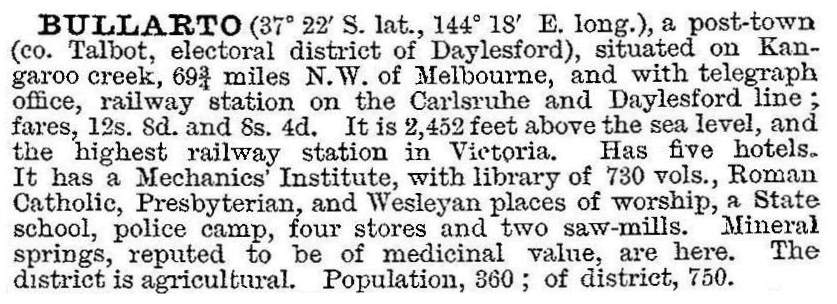Bullarto
Bullarto is a village in the Wombat Forest, 83 km north-west of Melbourne and 10 km south-east of Daylesford. According to Bunce's Language of the Aborigines of the Colony of Victoria (1859) Bullarto is an Aboriginal word meaning abundance and big.
Bullarto is about 735 metres above sea level, near the headwaters of the Kangaroo and Wombat Creeks on the inland side of the Dividing Range. The forests were a source of building and mine-works timber, and the local community established a school in 1873. In 1880 Bullarto was reached by the railway line which opened between Woodend and Daylesford, greatly stimulating the timber industry which had a ready market in the gold mines in Daylesford and further west. In 1886 the Victorian municipal directory described Bullarto as a rising place, with a mechanics' institute and excellent library, a church, two hotels with stores and a mineral spring. Sawmilling was extensive and the chocolate soil good for agriculture. Further growth was reported in the Australian handbook, 1903:

By the 1930s much of the millable timber was cut out and the Frith mill moved to Lyonville. A mill continued at Bullarto however until the early 2000s. The railway line closed in 1978.
Bullarto's buildings are distributed along the road between the old railway station and Bullarto South. They include the school (12 pupils, 2014) and the public hall (1910). After lobbying by residents in 2006 Bullarto was removed from Moorabool Shire and placed in Hepburn Shire. The Bullarto and Musk Community Action Plan was formulated in 2012-13, and one of its recommendation was the establishment of the Bullarto-to-Lyonville Rail Trail.
Bullarto's census populations have been:
| area | census date | population |
|---|---|---|
| Bullarto | 1891 | 360 |
| 1911 | 284 | |
| 1961 | 112 | |
| Bullarto and environs | 2006 | 358 |
| 2011 | not recorded |


